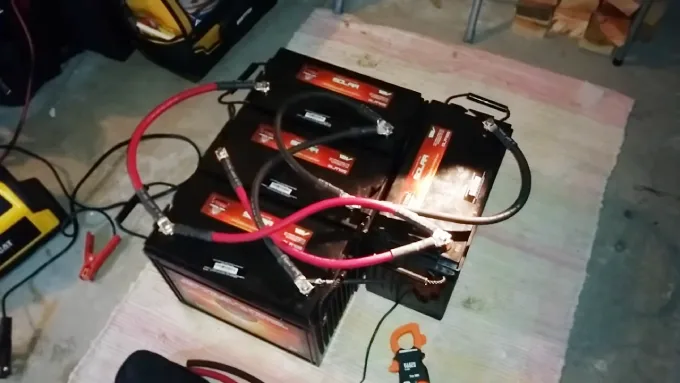Last Updated on May 1, 2023
As an avid RV traveler, you know the importance of a reliable and efficient power system. One crucial aspect of maintaining a healthy power system is ensuring that your RV batteries are in balance.
Getting three RV batteries balanced in parallel requires some simple steps, like preparing the batteries, checking the voltage levels, installing battery balancers, and monitoring the system. When balanced properly, it extends their lifespan, prevents electrical problems, and allows for worry-free travel.
Here we will walk you through balancing three RV batteries in parallel, sharing useful tips and tricks to ensure your RV will remain powered by a reliable source of electricity. So, let’s dive in.
How to Balance 3 RV Batteries in Parallel: An Overview
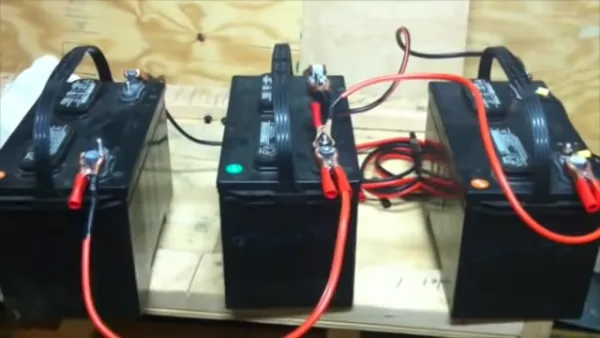
RV batteries are essential to any camping or road trip. They provide power for all the appliances and devices in your RV, from lights to refrigerators. However, connecting multiple RV batteries in parallel can be a great solution when you need more power.
When connecting RV batteries in parallel, it’s important to understand how they work together. Parallel connections involve connecting the positive terminals of each battery together and the negative terminals together.
This configuration increases the overall capacity of your battery system while maintaining a 12-volt output.
Types of RV Batteries
Regarding RV batteries, there are two main types: lead-acid and lithium-ion. Lead-acid batteries are the most common type of battery found in RVs. They are affordable and reliable but require regular maintenance to ensure they function properly. Lithium-ion batteries, on the other hand, are more expensive but require less maintenance and have a longer lifespan.
Within the lead-acid category, there are two subtypes: flooded and sealed. Flooded batteries have removable caps that allow easy inspection and maintenance, while sealed batteries are completely enclosed and require little to no maintenance. Sealed batteries are also known as valve-regulated lead-acid (VRLA) batteries.
When connecting multiple RV batteries in parallel, using the same type of battery for each connection is essential. Mixing different types or brands of batteries can lead to imbalances in the system and shorten the lifespan of the batteries.
Advantages of Connecting RV Batteries in Parallel
Connecting RV batteries in parallel is a popular way of increasing the power capacity of your RV. This method involves connecting two or more batteries of the same voltage and type to increase their overall capacity.
One of the biggest advantages of paralleling RV batteries is the increased power output. Adding more batteries allows you to run more appliances and devices longer without worrying about draining your battery bank too quickly.
Additionally, parallel connections provide redundancy, which means that if one battery fails, the others will continue to work, ensuring you always have power when needed.
Another advantage is that it allows for easier maintenance. With multiple batteries connected in parallel, you can easily replace one battery without affecting the rest of the system. This makes it easier to maintain your battery bank and keep it functioning properly.
Parallel connections also help extend the lifespan of your batteries by reducing the depth of discharge (DoD). When connected in parallel, they share the load evenly, meaning each battery is discharged less deeply than if used on its own. This reduces wear and tear on individual cells and extends their overall lifespan.
Challenges with Multiple RV Batteries Connected in Parallel
Multiple RV batteries connected in parallel can help increase your RV’s battery capacity, but it comes with challenges. One of the main challenges is balancing the batteries to ensure that each battery is discharging and charging at the same rate.
When multiple batteries are connected in parallel, they become one big battery bank with a higher amp-hour capacity. However, if one battery has a lower charge than the others, it will discharge faster and potentially damage the battery. This is why balancing your RV batteries is crucial.
One of the challenges with balancing multiple RV batteries in parallel is that each battery may have slightly different internal resistance and voltage levels. This can cause some batteries to discharge faster than others or not fully charge during charging cycles.
To overcome these challenges, you need to use battery balancers designed to monitor and balance the voltage levels of each battery in real time. Battery balancers work by diverting excess energy from fully charged batteries to undercharged ones until all the batteries reach an equal state of charge.
Another challenge when balancing multiple RV batteries is that it can be time-consuming and require some technical knowledge. You must prepare your batteries properly by cleaning them and ensuring they are all fully charged before connecting them in parallel.
It’s also important to regularly monitor your balanced battery system using a multimeter or voltmeter to ensure that all the batteries maintain similar voltage levels during use and charging cycles.
Balancing Multiple RV Batteries in Parallel
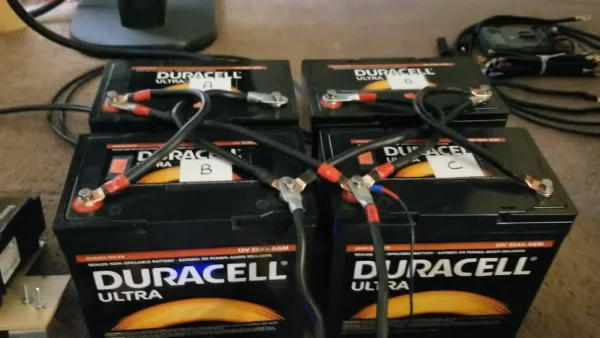
Balancing multiple RV batteries in parallel is a crucial task that every RV owner should know how to do. When you connect multiple batteries in parallel, it is important to ensure they are all balanced to prevent overcharging or undercharging of any one battery.
This section describes the tools and equipment needed for battery balancing and a step-by-step guide on balancing your RV batteries.
Tools and Equipment Needed for Battery Balancing
You will need a few tools and equipment to balance your batteries properly.
Firstly, you will need a digital voltmeter to measure the voltage levels of each battery. This will allow you to determine which batteries are over or undercharged and must be balanced.
Secondly, you will need a set of battery balancers. These devices are designed to equalize the charge between multiple batteries by transferring energy from fully charged to undercharged ones. Various types of battery balancers are available on the market, so it is important to choose one compatible with your specific type of RV battery.
Lastly, you may also want to invest in a battery monitor system that can provide real-time information about the state of your battery system. This can help you identify any potential issues before they become major problems.
Step-by-Step Guide to Balancing Your RV Batteries
Having prepared these tools, follow these simple steps once you have them ready:
Step 1: Preparing the Batteries
Before you start balancing your RV batteries, it’s important to prepare them properly to ensure a successful outcome. This involves a few simple steps that can make a big difference in the effectiveness of your battery balancing process.
Firstly, ensure all the batteries in your RV are fully charged before attempting to balance them. This is because battery balancing works best when all the batteries are at the same charge level. If one or more batteries are significantly discharged, it can throw off the entire system and make it difficult to achieve balance.
Next, check each battery for signs of damage, such as cracks or leaks. Replacing the affected battery before balancing is best if you notice any damage. Damaged batteries can cause safety hazards and may malfunction during the balancing process.
Once you’ve checked for damage, clean each battery terminal thoroughly using a wire brush or sandpaper to remove any corrosion or buildup. Corrosion on terminals can impede electrical flow and make it more difficult to achieve a balance between batteries.
After cleaning the terminals, connect all the batteries in parallel according to their positive and negative terminals using appropriate cables and connectors. Make sure all connections are tight and secure before proceeding with balancing.
Step 2: Checking Voltage Levels
When balancing multiple RV batteries in parallel, checking voltage levels is important to ensure that each battery functions properly and contributes equally to the overall power supply.
You will need a voltmeter to determine the voltage level of your RV batteries. These tools can measure the electrical potential difference between two points in a circuit and provide an accurate reading of the battery’s voltage.
Before checking the voltage levels, ensure all of your RV appliances are turned off and disconnected from the batteries. This will prevent any interference with your readings and ensure that you get an accurate measurement.
To check each battery’s voltage level, set your voltmeter to DC volts and touch the red probe to the positive terminal of one battery and the black probe to the negative terminal of the same battery. The voltmeter should display a reading between 12.4V and 12.7V for a fully charged 12V battery.
Repeat this process for each of your RV batteries in parallel, noting each reading. If any of the batteries have significantly lower voltages than the others, it could be experiencing issues such as sulfation or a dead cell.
Step 3: Installing Battery Balancers
You will need a few tools and equipment to install battery balancers, including a screwdriver, wire cutters, and crimping pliers. You will also need to purchase battery balancers that are compatible with your RV batteries.
The first step is to prepare the batteries by disconnecting them from all power sources and removing any covers or casings. Next, check each battery’s voltage level using a multimeter. If there is a significant difference between the voltage levels, charge the lower voltage batteries until they are at the same level as the others.
Once all batteries have been charged to the same level, installing the battery balancers is time. Follow the manufacturer’s instructions carefully and make sure to connect them properly. Typically, battery balancers are installed between each pair of batteries in parallel.
After installing the battery balancers, it’s important to monitor your balanced battery system regularly. Check for any signs of overcharging or undercharging and adjust accordingly. Proper maintenance practices for your RV batteries are essential to ensure they last longer.
Step 4: Monitoring the Balanced Battery System
Monitoring the balanced battery system helps you identify any issues and take corrective action before they become major problems.
One of the best ways to monitor your RV battery system is by using a battery monitor. Battery monitors measure the state of charge, voltage, and current flowing in and out of each battery. They provide real-time information about the health of your batteries and help you avoid overcharging or undercharging.
When monitoring your RV battery system, it’s also important to keep an eye on each battery’s voltage levels. If one battery has a significantly lower voltage than the others, it may be a sign that it’s not holding its charge as well as it should be. This could indicate a problem with the battery or the way it’s connected in parallel with other batteries.
Maintaining a Balanced Battery System for Your RV
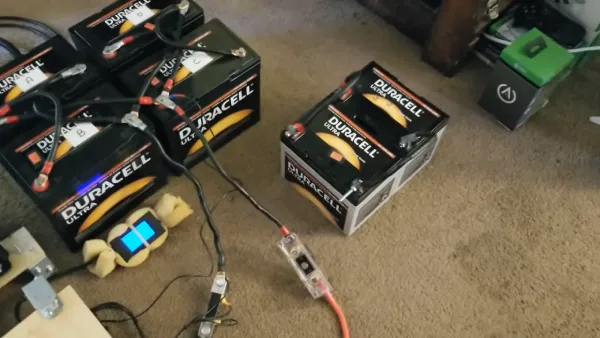
Keeping your RV’s batteries balanced is crucial to ensure your batteries’ optimal performance and longevity. A balanced battery system means that all the batteries in your RV are charged equally and have the same voltage levels.
This is important because if one battery has a higher voltage level than the others, it will discharge faster, causing an imbalance in the system.
Tips on How to Keep Your RV Batteries Balanced
Keeping your RV batteries balanced is crucial to ensure that they work efficiently and last longer. Here are some RV battery maintenance tips:
- Charge your batteries regularly: One of the main reasons for unbalanced RV battery systems is a lack of proper charging. Make sure you charge your batteries fully after each use and at least once every month during storage.
- Use a battery monitor: A battery monitor helps you keep track of the state of charge (SOC) of each battery in the system. This way, you can identify any discrepancies in SOC levels and take corrective measures.
- Avoid over-discharging your batteries: Over-discharging can cause irreversible damage to your RV batteries, leading to an unbalanced system. Use a low-voltage disconnect (LVD) or set the alarm to prevent over-discharging.
- Rotate your batteries: Rotating your batteries involves switching their positions periodically within the system. This helps distribute the load evenly across all batteries, preventing one from working harder than the others.
- Maintain proper water levels: If you have flooded lead-acid batteries, make sure you check and maintain proper water levels regularly. Low water levels can cause sulfation and reduce battery life.
- Avoid mixing old and new batteries: Mixing old and new batteries in a parallel system can lead to an unbalanced system since newer batteries tend to have higher capacities than older ones.
Common Mistakes to Avoid When Balancing Your RV Batteries
You should avoid some common mistakes to ensure your battery system remains balanced and efficient. Keep these things in mind:
- Mixing old and new batteries: It is important to use batteries of the same age and type when connecting them in parallel. If you mix old and new batteries, the older ones will discharge faster than the newer ones, which can cause an imbalance in the system.
- Overcharging or undercharging: Overcharging or undercharging your RV batteries can also lead to an unbalanced system. Make sure to monitor your battery voltage levels regularly and charge them appropriately.
- Improper installation of battery balancers: Battery balancers are essential for maintaining a balanced battery system but must be installed correctly. Follow the manufacturer’s instructions carefully when installing these devices.
- Neglecting maintenance: Regular maintenance is crucial for keeping your RV battery system balanced and efficient. Be sure to clean your batteries regularly, check their water levels, and inspect them for signs of damage or wear.
Troubleshooting Unbalanced RV Battery Systems
Even with proper balancing, issues can still arise in the system. Here are some standard troubleshooting tips for unbalanced RV battery systems:
- Check the voltage levels: If one or more batteries are consistently lower in voltage than the others, it could be a sign of an unbalanced system. Use a multimeter to test each battery’s voltage and compare them. If there is a significant difference between the readings, it may be time to rebalance the system.
- Inspect battery connections: Loose or corroded connections can cause your RV battery system imbalances. Check all connections and terminals to ensure they are clean and tight.
- Look for damaged batteries: A single damaged or defective battery can throw off the balance of your entire system. Inspect each battery for physical damage or signs of leakage.
- Consider adding more batteries: If you’re consistently experiencing unbalanced batteries despite your best efforts at balancing, you may need to add more batteries to your system to achieve better balance.
- Consult a professional: If you’re unsure how to troubleshoot an unbalanced RV battery system, consider consulting a professional specializing in RV electrical systems.
By taking these steps and addressing any issues promptly, you can maintain a balanced and reliable RV battery system for years to come.
How long does it take for RV batteries to equalize in parallel?
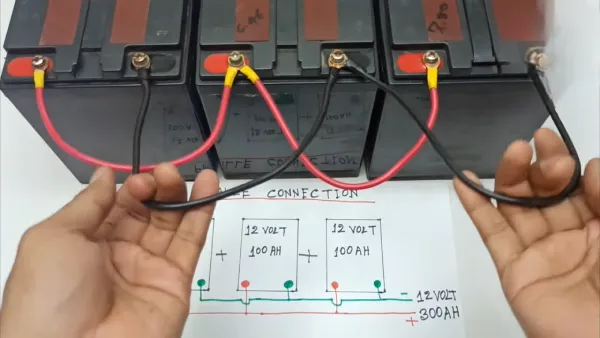
The process of equalizing RV batteries in parallel varies depending on several factors, such as the capacity of the batteries, their state of charge, and the charging current. Generally, the batteries can take several hours to a few days to fully equalize.
However, it’s important to note that they may not fully equalize even after this period due to small differences in their charge levels. Regular monitoring of their voltage levels and charge status is recommended to ensure that your RV batteries are properly equalized.
You can use a battery monitor or multimeter to check the voltage levels of each battery and adjust the charging rate accordingly to ensure that they all receive an equal charge.
It’s essential to note that equalizing batteries in parallel must be done cautiously to prevent overcharging or undercharging. Therefore, we recommend consulting with a professional before attempting to equalize RV batteries in parallel.
Can you equalize an RV battery too much?
It is possible to over-equalize an RV battery, resulting in damage and a shorter lifespan.
While equalizing can be beneficial in removing sulfate buildup and restoring capacity, using too high a voltage or completing the process for too long can cause the electrolyte to boil and result in excess gassing, leading to further damage even loss of electrolytes.
Adherence to the manufacturer’s guidelines for equalizing and charging your RV battery is crucial. Regular maintenance and proper techniques can significantly extend its life and guarantee stable power for your vehicle.
Does connecting two RV batteries in parallel increase amps?
Paralleling two RV batteries will increase the RV’s available amperage. When batteries are connected in parallel, the positive terminals are connected, and the negative terminals are also connected. This effectively increases the capacity of the battery bank, which results in more amperage available to power the RV.
However, it is important to ensure that the batteries have the same voltage and capacity to avoid any imbalances that can cause damage to the batteries or the RV electrical system.
Guarantee a Relaxing RV Trip: Balance Your Battery System
Balancing 3 RV batteries in parallel is crucial to maintain a healthy and efficient power system. You can save money and prevent potential electrical issues by implementing good habits and taking the necessary steps.
Regularly checking your battery’s voltage levels, using a battery balancer, and avoiding overcharging or undercharging your batteries are simple yet effective methods to ensure a balanced battery system. Follow these tips and tricks to ensure a smooth journey during your next RV trip.

